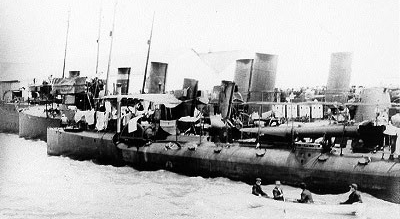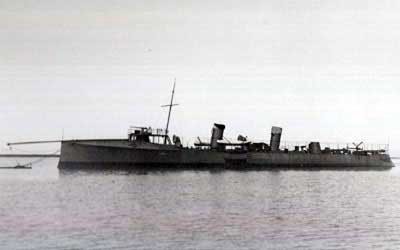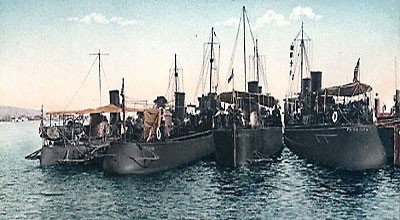1899-1919

The first U.S. Navy ship named to honor David Glasgow Farragut (5 July 1801-14 August 1870). See David Glasgow Farragut for additional information. The second Farragut (Destroyer No. 300), was reclassified to DD-300 on 17 July 1920, and served from 1920-1930. The third Farragut (DD-348) was renamed Smith on 15 July 1933, renamed Farragut on 12 August 1933, and served from 1934-1947. The fourth Farragut, a guided missile frigate (DLG-6), was projected as DL-6 but reclassified on 14 November 1956, reclassified as a guided missile destroyer (DDG-37) on 30 June 1975, and served from 1960-1992. The fifth Farragut (DDG-99) was commissioned on 10 June 2006.
I
(Torpedo Boat No. 11: displacement 279; length 214'8"; beam 20'8"; draft 6'; speed 30 knots; complement 66; armament 4 6-pounders, 2 18-inch torpedo tubes; class Farragut)
Farragut (Torpedo Boat No. 11) was laid down on 23 July 1897 at San Francisco, Calif., by Union Iron Works; launched on 16 July 1898; sponsored by Elizabeth Ashe, Adm. Farragut's niece; and commissioned on 22 March 1899, Lt. Cmdr. Reginald F. Nicholson in command.
The ship incurred a four month delay in her construction in order to obtain suitable engineering equipment “due to high rate of speed required, but not to inherent defects.” Farragut carried out her final sea trials on 16 June 1898, and the Navy accepted her on 3 July.

Farragut accomplished target and torpedo practice between Mare Island Navy Yard and Sausalito in San Francisco Bay, broken by occasional voyages southward to San Diego, Calif. She was decommissioned at Mare Island on 4 September 1902, and placed in commission in reserve on 8 October 1904.
The torpedo boat was restored to full commission at Mare Island for duty with the Pacific Torpedo Fleet on 23 March 1908, Lt. Martin K. Metcalf in command. She resumed her operations along the coast of California, and also participated in the Portland Rose Festival, Portland, Ore. (30 May–10 June 1908). The ship trained off the west coast through the remainder of the year, and conducted target practice on 23 April 1909. Farragut was placed in reserve at Mare Island on 17 September 1909.

She then became involved in a debate concerning the proposed reorganization of the Navy to improve efficiency. Rear Adm. Washington L. Capps, Chief Constructor, Bureau of Construction and Repair, testified before the House Committee on Naval Affairs concerning delays and expenses incurred by ships undergoing maintenance, on 26 January 1910. Capps explained that on 29 September 1909, men working on Farragut discovered a defect in a drum in one of her boilers. The Inspector of Machinery recommended that the Bureau of Steam Engineering rivet the defective weld, but the bureau disapproved the recommendation and directed the installation of a new drum. The Navy Yard did not possess the material, but the Naval Constructor-Manager recommended purchasing one from Union Iron Works, which had built Farragut and lay only 30 miles away. The ship subsequently accomplished her repairs, but the comparatively simple work escalated in cost and time.
Recommissioned at Mare Island on 10 May 1911, Ens. Henry R. Keller in command, Farragut operated primarily with the Pacific Torpedo Flotilla in the San Francisco area, aside from a cruise to Bremerton, Wash. (15 July-6 September). She was placed in First Reserve with the Reserve Torpedo Group at Mare Island on 1 June 1912, and Ens. Claude S. Gillette relieved Lt. Keller as the commanding officer on 6 June.
Farragut was placed in ordinary with the Reserve Torpedo Division at Mare Island on 26 March 1914, and then served as a training ship in the San Pedro Division of the California Naval Militia (12 January 1915-14 April 1917).
Following America’s entry into World War I, Farragut returned to full commission on 14 April 1917. She sailed for the Panama Canal Zone on 11 July 1917, and during the war patrolled both the Atlantic and Pacific entrances to the canal, and carried troops and supplies in the Balboa area.
Renamed Coast Torpedo Boat No. 5 in accordance with General Order No. 408 of 1 August 1918, she helped escort a convoy from Balboa on 30 December 1918, but incurred problems that necessitated submarine tender Beaver (Id. No. 2032) taking the warship in tow on 5 January 1919. On 15 January, they reached San Pedro. Another vessel then towed Coast Torpedo Boat No. 5 to Mare Island, where they arrived on 18 January. Coast Torpedo Boat No. 5 was decommissioned at Mare Island on 13 March 1919, and sold for $27,219 to Rodeo-Valleo Ferry Co., Rodeo, Calif., on 9 September 1919.
Mark L. Evans
3 June 2013


